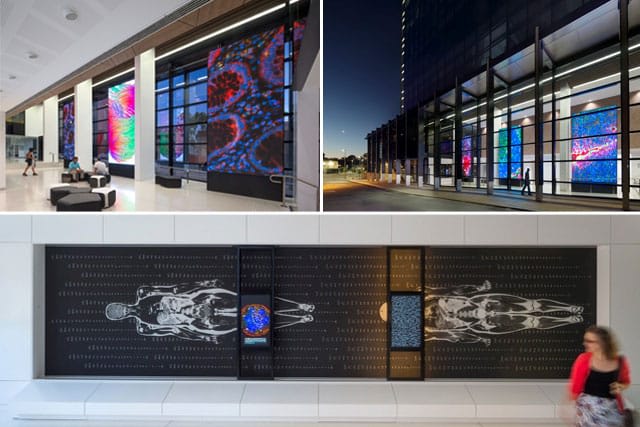
Australia is a world leader in medical research. For our researchers to keep delivering the medical breakthroughs that help people with cancer, diabetes, schizophrenia and other diseases, public trust and support is essential. For this reason, the Harry Perkins Institute of Medical Research commissioned exhibition spaces as a key part of its exciting new building.
Working with the building’s architects and interior designers, Hames Sharley, Freeman Ryan Design (FRD) created three spectacular installations to woo the public’s interest and reward their curiosity.
Funded by a generous grant from the official state lottery in Western Australia, Lotterywest, the first installation is a giant electronic artwork covering almost 100 square metres spread across three double-sided digital banners. The banners stand within the double-storey entry foyer and are an eye-catching feature from outside the building. Hundreds of slowly changing research images have been used by multi-media technologists at Lightwell to create an artwork that beautifully displays the splendour of our microscopic world in extraordinary detail.
“The images are a little enigmatic,” says architect-turned-exhibition designer, Susan Freeman, a co-founder of FRD. “But the inquisitive can look up the details for every image on an iPad attached to the display.”
Visible at the western end of the foyer outside the Institute’s public auditorium is an even larger installation, 10 metres long and 2.5 metres high. “This has a lot more detail,” says Freeman. “The background of this display is a single backlit membrane printed with over-sized MRI* scan images of a male and a female volunteer.”
A vertical beam of light travels the length of the installation, simulating the MRI scan. Two digital screens move in front of each image, stopping at points to run videos on Perkins research relating to each part of the body. “When it stops in front of the heart, it tells a story about the Perkins heart researchers, and the breakthroughs in coronary research the institute has made,” Freeman says. A soundscape of whirring, clicking, heartbeats and other sounds recorded in hospitals and laboratories adds an intriguing further dimension to the experience.
Upstairs, in a more intimate space, an exhibition has been created with schools and university students in mind, with artefacts, printed graphic panels, an interactive touch screen and miniature video screens.
All three exhibitions are designed to foster a strong engagement between the community and the institute, and inspire students to pursue research. Freeman says: “The researchers’ work is amazing and we have tried to show that in a way the public can understand and relate to.”






